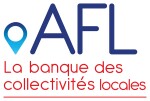Today, AFL displays a positive balance sheet. In a chaotic geopolitical environment and amid high economic uncertainty in France, how do you explain these robust figures?

The local government funding agency model is powerful and resilient. In France, we are the only bank that is fully owned by local governments, which are also our unique shareholders. We conduct 100% of our business with these members, who borrow exclusively to fund their capital expenditure.
Our ambition is not to pay out immediate dividends: we reinvest the proceeds from our credit business into our equity capital to bolster our lending capacity.
With an optimal prudential treatment, on account of the 0% risk weighting of our members and their guarantee, our goal is to become a key market player for our members. As such, over the past two years, we have already become the largest lending institution for our shareholders.
Your investor base includes over 300 international players. What is your market positioning? Why do investors choose to work with AFL?
After 10 years in business, AFL now has a sovereign-like rating, and its debt securities qualify as HQLA1 [high-quality liquid assets level one]. These are guaranteed by entities that are essentially 0% risk weighted and, using the substitution approach, they are weighted at approximately 5%. Though admittedly not zero, 5% is better than either 20% or the 10% risk weighting of covered bonds. Our issuances are increasingly liquid, and we are now strategically entering other public markets outside the euro, notably the sterling market in 2022 and Swiss franc in 2024. We are now considering the Australian dollar public market.
This broader presence has already enabled AFL to build a name in many international markets. The strategy has also allowed us to fulfil one our main mandates: to increase lender diversification on behalf of our members.
Readability is very high for investors. AFL offers investors exposure that mirrors local sector risk: the more we grow, the more our members reflect the average sector risk. AFL’s role is to provide investors with liquidity — which no French local government agency can supply. Four issuances are each worth at least €1bn, including one €1.25bn issuance. In time, AFL is poised to become an increasingly important issuer.
This year marks your 10th anniversary. Where do you see AFL 10 years from now?
AFL membership is growing at a sustained pace: 103 new members in 2022, 177 in 2023 and 269 in 2024. We closed the first quarter of 2025 with 1,101 shareholders. If we maintain this pace, we could gain around 1,000 new members every four years. Therefore, in 10 years, I see AFL representing around 3,000 local government bodies and issuing approximately €4bn per year.
To achieve this, we must continue to invest massively in our IT systems. One of AFL’s key strengths is that we do not run a network, thereby easing the bureaucratic burden both for local governments and for us. We intend to keep following this course over the next 10 years. We just finalised our new Information System Master Plan to help the bank manage such a development with limited resources through a strong industrialisation of processes. See you in 10 years.
Record activity and robust earnings(Earnings at 31/12/2024 — consolidated data for AFL Group under IFRS standards)

The record volume of credit production for member local authorities contributed to the growth of AFL’s core business revenues in 2024. The group’s gross operating income rose to €7.8mn, confirming AFL’s ability to generate revenue growth (excluding exceptional events) and strengthen its balance sheet in a negative environment, as demonstrated by its very comfortable capital and liquidity ratios. General operating expenses over the period only posted a modest 3% increase year on year. At €381,000, the cost of risk is intrinsically low owing to the nature of the balance sheet exposures, the excellent solvency of local governments and the cautious management of the company. |


